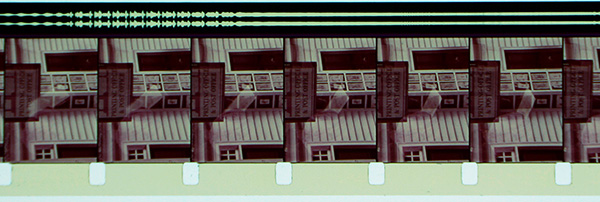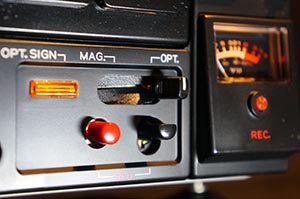What do you suppose was the biggest advancement in motion pictures in the early days? In my opinion it had to be the invention of the "talkie." Adding sound to film was a modern miracle that soon became commonplace in the sound film standards still in use today. Granted all that innovative technology has largely been replaced by video, but there are still sound films out there that want to be transferred to the digital age, and Advent Digitizing has what it takes to do just that.
We can digitize16mm and Super 8mm sound films that have both types of soundtracks: magnetic or optical. How do these work and how do you know when you have one? This article answers those questions.
Optical Sound
 Optical sound records sound as varying density patterns or squiggles along one edge of the film. In the projector a light source beams a slit of light through the film onto a photocell which converts the light patterns to electrical impulses. These are then amplified and sound is heard through the speaker.
Optical sound records sound as varying density patterns or squiggles along one edge of the film. In the projector a light source beams a slit of light through the film onto a photocell which converts the light patterns to electrical impulses. These are then amplified and sound is heard through the speaker.
You’ll find optical sound mostly on professionally produced films, because creating an optical soundtrack is done in the film processing lab – a system that was perfected 100 years ago.
Whether a feature, a short, or educational title, the picture was usually shot on negative film, and the sound was recorded on a separate tape or film recorder that could sync to the film negative. A special device would convert the sound to the optical pattern on a negative separate from the master picture negative. In creating the release prints, the two negatives were exposed to the release film, and when developed, you had a sound film ready to show.
Optical sound is notoriously "lo-fi," especially on 16mm and Super 8. The film doesn't run fast enough to resolve high frequencies beyond 6KHz or so, and artifacts are heard from dirt and scratches on the film.
Optical sound is common on 16mm commercial films, but occasionally we'll find a Super 8mm optical sound film. This format was most often used in point-of-sale kiosk type displays, using a continuous loop cartridge and a special self-contained player. We've discovered there were some Super 8 optical sound features or shorts sold in the 70s. Super 8mm optical sound projectors are very rare...but we found one, and it works!
Magnetic Sound
 Magnetic sound uses a magnetic stripe (aka "mag stripe" – usually brown) of magnetic oxide on one edge of the film. A head like a tape recorder's head rides in contact with the strip to write or read sound on the soundtrack stripe just like a tape recorder would. As a result, magnetic sound has a crisper, cleaner sound than optical.
Magnetic sound uses a magnetic stripe (aka "mag stripe" – usually brown) of magnetic oxide on one edge of the film. A head like a tape recorder's head rides in contact with the strip to write or read sound on the soundtrack stripe just like a tape recorder would. As a result, magnetic sound has a crisper, cleaner sound than optical.
Magnetic film came about as audio tape technology evolved. In the 1960s it was used to record sync sound for conversion to optical sound, and other uses. For instance the original 3-strip Cinerama used multi-track magnetic film for early surround sound in theaters.
Mag sound for 16mm found its real niche in TV news gathering. To do the live shot like we’re all used to today, they’d use unexposed Kodachrome or Ektachrome film with the mag stripe already on it (like this illustration). The news gathering camera had the appropriate heads to record sound on the film as it was being shot. They’d then rush the news footage to the studio where they’d process it and run it on the film chain projector during the newscast. That’s why they always said, “Film at eleven!”
Meanwhile in the 1950s and 60s the 8mm and Super 8mm home movie fad had taken root, and consumers wanted to add sound to their films. Manufacturers first brought out regular 8 sound movie projectors. You could send your movies out to have the mag stripe added, then you could record narration or add music to your films to further bore your guests. Release prints of cartoons and theatrical shorts were sold with magnetic sound.
When Super 8 was invented, film with the mag stripe became available, just like for news crews, and specialty cameras and projectors finally brought synchronized sound to home movies. This turned out to be the most effective way to add sound to home movies, but there were other schemes tried. Bell & Howell, for one, made a camera system that used an external cassette tape recorder. The camera would record sync pulses on the tape along with the sound, and their special projector would use those pulses to sync the sound to the picture. (I sold those at a department store around 1972.)
Sound home movies were quite the rage for a while. They were complex and expensive, but just before they could reach the scale where costs could come down a funny thing happened…VHS.
Sound Film Samples
Here are samples of recent films we've transferred with sound (sources are public domain).
Transferring Sound Films
 Here’s the bottom line: If you have sound films in your closet, wouldn’t you like to hear as well as see them again? At Advent Digitizing we can transfer magnetic or optical 16mm or Super 8. And even if you have one of those Bell & Howell synced cassettes, we can make that work too.
Here’s the bottom line: If you have sound films in your closet, wouldn’t you like to hear as well as see them again? At Advent Digitizing we can transfer magnetic or optical 16mm or Super 8. And even if you have one of those Bell & Howell synced cassettes, we can make that work too.
We use a multi-step process. First, we capture the picture on our high-resolution film scanner (and for optical sound, we also capture the soundtrack image.) Second, for magnetic sound we run the film on one of our sound projectors to capture reference video with sound, and for optical sound we process the optical pattern through AEO-Light software to extract a digital soundtrack. Then we marry the two in Premier Pro to provide you with a perfectly synchronized sound video.
The “Box” transfer outfits won’t touch sound film. Let Advent Digitizing bring you the sound from those films you’ve been longing to hear.
Contact us to schedule your sound film transfer!